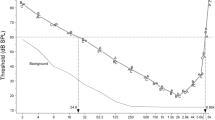Summary
A new normal threshold of hearing of cat (monoaural) for free field listening was determined by behavioural audiometry and this was compared with cat's hearing thresholds obtained by other techniques of behavioural audiometry. The absolute hearing thresholds obtained in the present study are slightly lower than those of other authors at many test frequencies. This appears to be due to different conditioning techniques and testing methods which are used to determine hearing thresholds. Any large interindividual variability in absolute hearing threshold at any test frequency resulted from differences in the technique and method of obtaining the thresholds and not from differences in hearing ability of the animals.
Zusammenfassung
An einseitig labyrinthektomierten Katzen wurde nach „push-pull” Konditionierung verhaltensaudiometrisch die normale Hörschwelle im freien Schallfeld bestimmt und mit den durch andere Methoden der Verhaltensaudiometrie ermittelten Katzenhörschwellen verglichen. Die in den vorliegenden Untersuchungen gefundenen absoluten Hörschwellen sind in vielen Prüffrequenzen geringgradig niedriger als die. von- anderen Autoren bestimmten. Das dürfte eine Folge der verschiedenen Konditionierungstechniken und Prufmethoden sein, die bei der Restimmung der Hörschwelle benutzt wurden. Die hier verwendete Technik der Verhaltensaudiometrie ermöglicht es, daß die Katze auf den schwächsten Schallreiz reagiert. Nach einem ausreichenden Konditionierungstraining lag bei den Audiogrammen aller Katzen eine auffallende Übereinstimmung vor (interindividuelle Übereinstimmung). Größere interindividuelle Abweichungen der absoluten Hörschwelle dürften also auf unterschiedliche Prüfmethoden und Konditionierungstechnik der Hörschwellenbestimmung und nicht auf Unterschiede in der Hörfähigkeit der Katzen zurückzuführen sein.
Similar content being viewed by others
References
British Standard Institution: The normal threshold of hearing for pure tones by Earphone listening. (B. S. 2497), 1954.
Elliot, D. N., Stein, L., Harrison, M. J.:Determination of absolute-intensity thresholds and frequency-difference thresholds in cats. J. acoust. Sec. Amer. 32, 380–384 (1960).
McGill, T. E.: Auditory sensitivity and the magnitude of the cochlear potentials. Ann. Otol. (St. Louis) 68, 193–207 (1959).
Miller, J. D., Watson, C. S., Covell, W. P.: Deafening effects of noise on the cat. Acta otolaryng. (Stockh.), Suppl. 176, 91 (1963).
Neff, W. D., Hind, J. E.: Auditory thresholds of the cat. J. acoust. Soc. Amer. 27, 480–483 (1955).
Robinson, D. W., Dadson, R. S.: A re-determination of the equal-loudness relations for pure tones. Brit. J. appl. Physics. 7, 166–181 (1956).
Schuknecht, H. F.: Technique for study of cochlear function and pathology in experimental animals. Development of the anatomical frequency scale for the cat. Arch. Otolaryng. 58, 377–397 (1953).
Sokolovski, A.: Behavioural technique for measuring auditory thresholds in cats (Film, 18 min). IX Inter. Cong. Audiol. London 1968.
Sokolovski, A.: “Push-pull” conditioning technique for measuring auditory thresholds in cats. Arch. klin. exp. Ohr.-,Nas.- u. Kehlk. Heilk. 203, 87–108 (1972 a).
Sokolovski, A.: The protective action of the stapedius muscle in noise-induced hearing loss in cats. (In press). 1973.
Author information
Authors and Affiliations
Additional information
Part of a Thesis approved by the University of London for the Ph. D. Degree in Medicine, 1969.
Rights and permissions
About this article
Cite this article
Sokolovski, A. Normal threshold of hearing for cat for free-field listening. Arch. klin. exp. Ohr.-, Nas.- u. Kehlk.Heilk. 203, 232–240 (1973). https://doi.org/10.1007/BF00344934
Received:
Issue Date:
DOI: https://doi.org/10.1007/BF00344934




